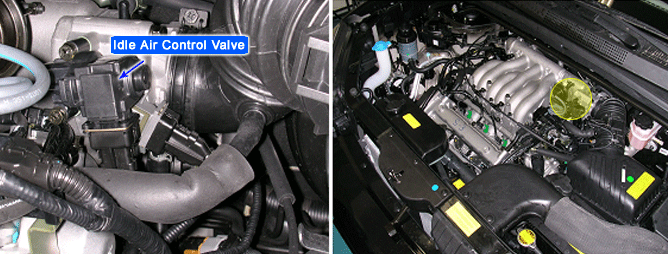Has a problem been found?

▶ Repair as necessary and go to "Verification of Vehicle Repair" procedure.

▶ Go to "Componment Inspection" procedure.

When the TP sensor's signal indicates closed throttle position and the engine is idling, the ECM adjusts the idle speed control actuator so that the engine runs at the correct idling speed, regardless of coolant temperature, load and etc. When the additional load applied in the engine, the air flow through the idle speed control actuator is increased momentarily to raise the idling speed.
The ECM monitors engine speed deviation from the target idle engine speed when the vehicle is stopped and the idle speed valve opening is stable. The ECM sets DTC P0507 if the difference to the target idle engine speed is lower than the predetermined threshold.
ITEM | DETECTING CONDITION | POSSIBLE CAUSE |
DTC Strategy | ● Compare engine speed and nominal idle speed in idle state | ● A stuck or binding throttle plate ● Misadjustment of the accelerator cable ● Contact resistance in connectors ● Faulty ICA valve |
Enable Conditions | ● Vehicle speed =0 ● Coolant temperature〉75℃(167℉) ● Engine load 〈280 mg/stk ● Throttle angle:closed ● Minimum time after start:15sec. ● Canister purge control 〈50% | |
Threshold Value | ● Engine speed 〉 (target RPM + 200) | |
Diagnostic Time | ● 35 sec. |

Many malfunctions in the electrical system are caused by poor harness(es) and terminals. Faults can also be caused by interference from other electrical systems, and mechanical or chemical damage.
Thoroughly check connectors for looseness, poor connection, bending, corrosion, contamination, deterioration, or damage.
Has a problem been found?

▶ Repair as necessary and go to "Verification of Vehicle Repair" procedure.

▶ Go to "Componment Inspection" procedure.
Visually/physically inspect the air leakage in intake/exhaust system as following items,
If OK, go to next step.
If NG, repair as necessary and go to "Verification of Vehicle Repair" procedure.
Vacuum hoses for splits, kinks and improper connections.
Throttle body gasket.
Gasket between intake manifold and cylinder head.
Seals between intake manifold and fuel injectors.
Exhaust system between HO2S and Three way catalyst for air leakage.
Check for air leakage in EVAP. Purge control valve
Remove the manifold side vacuum hose from the EVAP canister purge valve.
Using a hand vacuum pump apply specified vacuum(Approx. 15 in, Hg) to the manifold side of the valve
Does the valve hold vacuum?

▶ Go to next step as below.

▶ Repair as necessary and go to "Verification of Vehicle Repair" procedure.
Ignition "OFF"
Remove ICA from Throttle body and Check for throttle bore, throttle plate and the ICA passages for chocking and for any foreign objects. Repair or clean as necessary
Ignition "ON" & Engine "OFF".
Connect scan tool and select "IDLE SPEED ACTUATOR" parameter on the "ACTUATION TEST" mode.
Activates ICA by pressing "STAT" key
Check the ICA for clicking sound and visually verifying valve closes and opens
Repeat numerous times to ensure valve reliability
Is ICA OK?

▶ Check for poor connection between ECM and component: backed out terminal, improper mating, broken locks or poor terminal to wire connection. Repair as necessary and go to "Verification of Vehicle Repair" procedure

▶ Check ICA valve for contamination, deterioration, or damage. Substitute with a known-good ICA valve and check for proper operation. If the problem is corrected, replace ICA valve and then go to "Verification of Vehicle Repair" procedure
After a repair, it is essential to verify that the fault has been corrected.
Connect scan tool and select "Diagnostic Trouble Codes(DTCs)" mode.
Press F4(DTAL) and confirm that "DTC Readiness Flag" indicates "Complete". If not, drive the vehicle within conditions noted in the freeze frame data or enable conditions.
Read "DTC Status" parameter.
Is parameter displayed "History(Not Present) fault"?

▶ System performing to specification at this time. Clear the DTC

▶ Go to the applicable troubleshooting procedure.